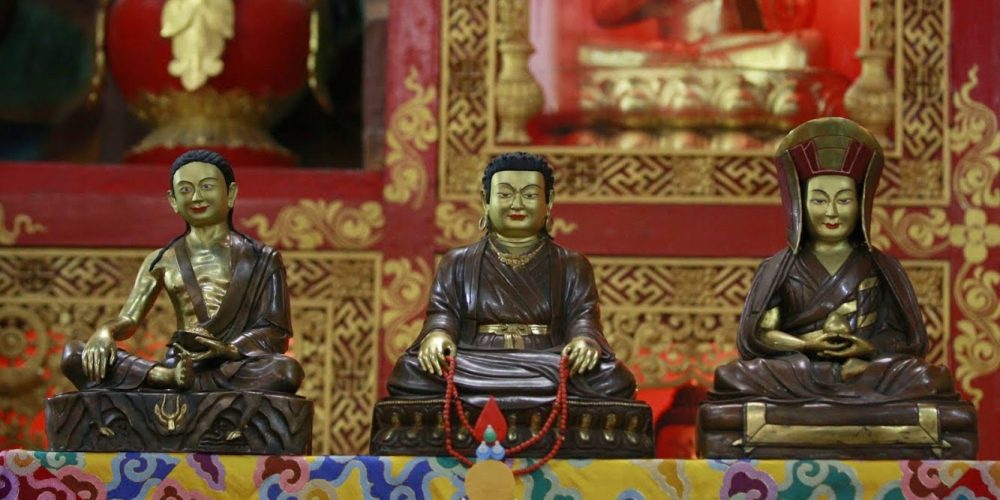The Golden Rosary of the Karma Kagyu Lineage
The forefathers in the Kagyu lineage are known as the “Golden Rosary.” The lineage of the Kagyu emphasizes the continuity of oral instructions passed on from master to student.

Image: Statues of the Kagyu forefathers, Milarepa, Marpa, and Gampopa, designed by the 17th Karmapa and presented to the main Kagyu monasteries
This emphasis is reflected in the literal meaning of “Kagyu.” The first syllable “Ka” refers to the scriptures of the Buddha and the oral instructions of the guru. “Ka” has the sense both of the enlightened meaning conveyed by the words of the teacher, as well as the force that such words of insight carries. The second syllable “gyu” means lineage or tradition. Together, these syllables mean “the lineage of the oral instructions.”
At the right is a detailed list of the Golden Rosary figures. Each name is clickable and takes you to further details on the main figures of the lineage, including the lineage of the Karmapas. Below is a short synopsis of the Kagyu lineage and a brief remark on some of the great founders who established this ancient tradition and passed it on from “mouth to ear” for so many centuries.
KAGYU LINEAGE
The Kagyu Lineage traces its origin back to the historic Buddha, Shakyamuni through Marpa, the great translator and yogi, who brought the unbroken lineage from India to Tibet.
Marpa The Translator
Marpa first trained as a translator under Drogmi Yeshe (993-1050), and then traveled three times to India and four times to Nepal in search of buddhist teachings. He is said to have studied with a hundred and eight masters and yogis, but his principal teachers were Naropa and Maitripa.
TILOPA AND NAROPA
From Naropa, Marpa received the lineage of tantric teachings called the Four Special Transmissions (bK’a-babs-bzhi): the yogas of 1) illusory body and transference of consciousness, 2) dream, 3) luminosity, and 4) inner heat. Naropa obtained these teachings directly from Tilopa (988-1069), who in turn had received them from two original sources, called the direct and indirect lineage. The direct lineage and original source of the teachings was Buddha Vajradhara. The indirect lineage comes from four main teachers of Tilopa called the “four special transmission lineages.” Both Tilopa and Naropa are some of the greatest panditas, scholars, and siddhas, accomplished saints, of Nalanda, the famous Buddhist university of ancient India.
MILAREPA
Marpa brought these lineages to Tibet, passing them on to his primary disciple and lineage holder, Milarepa (1040-1123), the most renowned and accomplished of Tibet’s tantric yogis, who achieved enlightenment in one lifetime. Milarepa held the lineage and tradition of the Practice Lineage. Some of the other great students of Marpa were Ngog Choku Dorjey, Tsurton Wangey and Meton Chenpo, who held the Marpa’s tradition of the Teaching Lineage. This is how the two great systems of the practice lineage and the teaching lineage were founded in Kagyu lineage.
GAMPOPA
The great master Gampopa (1084-1161), also known as Dakpo Lhaje, and Rechungpa (1084-1161) were the principal students of Milarepa. Gampopa was prophesized in the sutras by Buddha. He pioneered in establishing the framework of the lineage by unifying Milarepa’s Mahamudra lineage with the stages of the path tradition of the Kadampa lineage. This lineage and tradition is known as the Dhakpo Kagyu.
Gampopa had three heart disciples: Düsum Khyenpa, Phakmo Drupa and Saltong Shogom. Düsum Khyenpa (1110-1193), also known as Khampa Usey (literally, the “white-haired Khampa”), became known as the First Karmapa, who established the Karma Kagyu lineage.[/vc_column_text][/vc_column][/vc_row]


